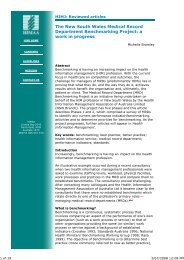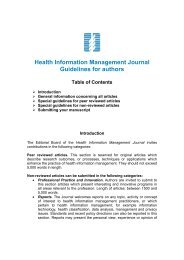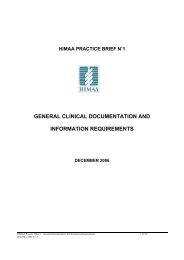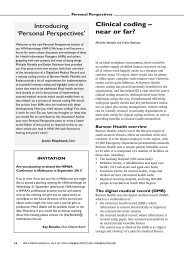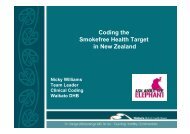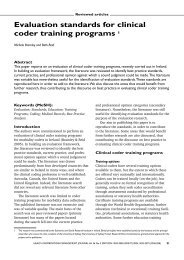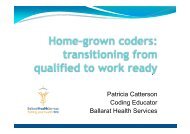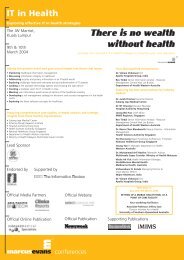Determinants of job satisfaction and effectiveness among health ...
Determinants of job satisfaction and effectiveness among health ...
Determinants of job satisfaction and effectiveness among health ...
Create successful ePaper yourself
Turn your PDF publications into a flip-book with our unique Google optimized e-Paper software.
Reviewed articles<br />
<strong>Determinants</strong> <strong>of</strong> <strong>job</strong> <strong>satisfaction</strong> <strong>and</strong> <strong>effectiveness</strong> <strong>among</strong> <strong>health</strong><br />
information administration pr<strong>of</strong>essionals in Kuwait<br />
Naser Al Enezi, Makhdoom Ali Shah, Rafiqul Islam Chowdhury <strong>and</strong> Margret Amatayakul<br />
Abstract<br />
Job <strong>satisfaction</strong> <strong>and</strong> organisational <strong>effectiveness</strong> <strong>among</strong> <strong>health</strong> information administration pr<strong>of</strong>essionals<br />
were analysed in relation to selected background, work environment <strong>and</strong> organisational characteristics. The<br />
data comprised a 15% (n = 171) r<strong>and</strong>om sample <strong>of</strong> <strong>health</strong> information administration pr<strong>of</strong>essionals in Kuwait,<br />
<strong>of</strong> whom 91.2% (n = 156) responded. It was found that remuneration compatible with qualifications,<br />
opportunity for continuing education, <strong>and</strong> work experience had a significant <strong>and</strong> positive relationship to <strong>job</strong><br />
<strong>satisfaction</strong>. It was concluded that the provision <strong>of</strong> continuing education, availability <strong>of</strong> orientation <strong>and</strong> <strong>job</strong><br />
description, effective supervision, <strong>and</strong> remuneration compatible with qualifications are facilitators <strong>of</strong> <strong>job</strong><br />
<strong>satisfaction</strong> <strong>and</strong> organisational <strong>effectiveness</strong>.<br />
Keywords: organisational <strong>effectiveness</strong>, <strong>health</strong> information administrator, <strong>health</strong> information manager,<br />
<strong>job</strong> <strong>satisfaction</strong>, medical record department, <strong>health</strong> information service, work environment<br />
Introduction<br />
The Medical Record Departments in Kuwaiti hospitals<br />
are headed by a Medical Record Director. Regardless<br />
<strong>of</strong> how the department or its director is titled, the<br />
Medical Record Department is the gateway to the<br />
<strong>health</strong> care delivery facility. In a properly managed<br />
<strong>health</strong> care facility, no <strong>health</strong> care services can be<br />
provided optimally by a care provider unless the patient<br />
medical record file, giving details <strong>of</strong> all the past<br />
episodes <strong>and</strong> care provided, is available.<br />
A hospital Medical Record Department is called by<br />
different names in different countries; for example,<br />
the title in North America is Health Information Administration<br />
Department, whereas in Australia it is<br />
usually Health Information Service. However, in view<br />
<strong>of</strong> the name change <strong>of</strong> the pr<strong>of</strong>essional American<br />
licensing body from American Medical Record Association<br />
(AMRA) to American Health Information Management<br />
Association (AHIMA) it is our view that the<br />
department head in Kuwaiti hospitals should now be<br />
called Health Information Manager (HIM). In Kuwait,<br />
Health Information Administrators (HIAs) are graduates<br />
<strong>of</strong> the Faculty <strong>of</strong> Allied Health Sciences <strong>and</strong> Nursing<br />
at Kuwait University.<br />
Considerable international <strong>and</strong> some local Kuwaiti<br />
research has been undertaken on <strong>job</strong> <strong>satisfaction</strong><br />
<strong>among</strong> allied <strong>health</strong> pr<strong>of</strong>essionals such as pharmacists,<br />
medical laboratory technologists <strong>and</strong> nurses, <strong>and</strong> its<br />
effects on their work performance. However, there is<br />
limited evidence <strong>of</strong> such research involving <strong>job</strong> <strong>satisfaction</strong><br />
<strong>among</strong> HIAs or their equivalent (Carter 1997).<br />
Job <strong>satisfaction</strong> is related positively to <strong>job</strong> retention<br />
(Kramer & Schmalenberg 1991; Brunner 1989), while<br />
lack <strong>of</strong> <strong>job</strong> <strong>satisfaction</strong> is one <strong>of</strong> the major reasons for<br />
a high staff turnover (Bailey et al 1980; Frisina et al<br />
1988). Research has also established that perceived<br />
fair rewards act as a predictor <strong>of</strong> <strong>job</strong> <strong>satisfaction</strong><br />
(Blegen & Mueller 1987). Intrinsic factors such as<br />
self-esteem, respect <strong>and</strong> recognition, autonomy in<br />
pr<strong>of</strong>essional work, use <strong>of</strong> expertise, <strong>and</strong> control, have<br />
been found to be more important than extrinsic factors<br />
such as pay <strong>and</strong> work load (Conant & Kleiner 1998;<br />
Oleckno & Blacconiere 1995; Frisina et al 1988). In a<br />
Hong Kong study, autonomy, pr<strong>of</strong>essional status, <strong>and</strong><br />
pay were valued more than interaction, task requirements,<br />
<strong>and</strong> organisational policies (Fung-kam 1998).<br />
Muncey (1998) reported that self-esteem was extremely<br />
important for coping with <strong>job</strong> pressures. In<br />
another study, personal <strong>and</strong> pr<strong>of</strong>essional development<br />
needs were considered to be important for the success<br />
<strong>of</strong> care providers (Jasper 1996).<br />
In light <strong>of</strong> the above findings, it can be inferred<br />
that if HIAs are not satisfied with their <strong>job</strong>s, the overall<br />
quality <strong>of</strong> their work will be affected negatively.<br />
This will have a negative <strong>and</strong> damaging effect on the<br />
quality <strong>of</strong> medical record services (Rudman & Gumbita<br />
1995; Carter 1997; Selvadurai 1991). Ultimately, the<br />
overall quality <strong>of</strong> <strong>health</strong> care provided will be affected<br />
negatively, as care providers have to rely on a proper<br />
medical record.<br />
There have been some studies undertaken in Kuwait<br />
on the <strong>job</strong> <strong>satisfaction</strong> <strong>of</strong> physicians, pharmacists,<br />
medical laboratory technologists <strong>and</strong> nurses (Al-<br />
K<strong>and</strong>ari & Ogundeyin 1998; Al-Zaid, Buhamra & Al-<br />
Ibrahim 1998; Al-Enzi 1998; Shah et al 2001). However,<br />
so far, no study has been undertaken in Kuwait<br />
on <strong>job</strong> <strong>satisfaction</strong> <strong>of</strong> HIAs <strong>and</strong> its effect on their <strong>job</strong><br />
performance; this research aimed to fill that void.<br />
This paper has two objectives, the first <strong>of</strong> which is<br />
to examine the differences in the reported work environment<br />
characteristics <strong>of</strong> <strong>health</strong> information administration<br />
pr<strong>of</strong>essionals, according to qualifications. The<br />
second objective is to analyse the differences in <strong>job</strong><br />
<strong>satisfaction</strong> <strong>of</strong> four categories <strong>of</strong> <strong>health</strong> information<br />
administration pr<strong>of</strong>essionals in relation to specific<br />
background, environmental, <strong>and</strong> organisational characteristics.<br />
The four categories <strong>of</strong> <strong>health</strong> information<br />
management pr<strong>of</strong>essional in Kuwait are those who<br />
have successfully completed (i) a university baccalaureate<br />
degree; (ii) an associate degree (diploma); (iii)<br />
higher secondary school education; <strong>and</strong> (iv) a special<br />
course in medical record science.<br />
Method<br />
Sample<br />
The study population comprised all <strong>health</strong> information<br />
administration pr<strong>of</strong>essionals in the four categories employed<br />
in the six general <strong>and</strong> ten tertiary care hospitals,<br />
Ministry <strong>of</strong> Health, Kuwait. There were 1142<br />
Health Information Management 2003 ISSN 1322-4913 Vol 32 No 2 Page 59
Reviewed articles<br />
1: Characteristics <strong>of</strong> the study population<br />
Characteristics n =156* %<br />
Position<br />
Director/ Assistant Director 21 13<br />
Supervisor 28 18<br />
Medical record clerk 107 69<br />
Age<br />
< 30 years 66 44<br />
30 – 34 years 40 27<br />
35 years 44 29<br />
Sex<br />
Male 18 12<br />
Female 138 88<br />
Salary<br />
< KD * 300 33 21<br />
KD 300 – KD 399 61 40<br />
KD 400 – KD 499 27 17<br />
500 KD 500 32 21<br />
Experience<br />
< 5 years 40 26<br />
5– 9 years 54 35<br />
10 years 61 39<br />
*Some <strong>of</strong> the 'n' do not add to the total because <strong>of</strong> missing<br />
values. One Kuwaiti dinar (KD) = US$3.27 or A$5.04<br />
employees in those categories as <strong>of</strong> June 2000: 31<br />
baccalaureate degree holders; 184 three-year diploma<br />
holders; 739 who had completed a one-year special<br />
course in medical record science after graduating from<br />
higher secondary school; <strong>and</strong> 188 who had completed<br />
only a higher secondary school education. A fifteen<br />
percent sample (n = 171) was selected for the purpose<br />
<strong>of</strong> this study. Since the baccalaureate degree<br />
holders represented only 2.7% <strong>of</strong> the workforce, it<br />
was decided to over-sample that segment. The response<br />
rate was 91.2%. One hundred <strong>and</strong> fifty-six<br />
questionnaires were completed by 17 baccalaureate<br />
degree holders, 24 diploma holders, 72 subjects who<br />
had completed special courses, <strong>and</strong> 43 subjects who<br />
had completed only secondary or higher secondary<br />
school education.<br />
Procedure<br />
Data were collected through a self-administered questionnaire.<br />
After reviewing the literature in this area<br />
<strong>and</strong> a number <strong>of</strong> instruments used for <strong>job</strong> <strong>satisfaction</strong><br />
studies (Shah et al 2001; Abu-Ajemieh et al 1996), six<br />
questions on socio-demographic characteristics, work<br />
environment <strong>and</strong> organisational variables were included<br />
in the measurement. In addition, eight questions<br />
were designed to measure the subjects’<br />
pr<strong>of</strong>essional <strong>and</strong> organisational <strong>job</strong> <strong>satisfaction</strong> <strong>and</strong> a<br />
single question was included to measure their overall<br />
<strong>job</strong> <strong>satisfaction</strong>. All <strong>of</strong> the nine outcome variables<br />
were measured on a five-point Likert scale: 5 very<br />
satisfied; 4 satisfied; 3 neither satisfied nor dissatisfied;<br />
2 dissatisfied; <strong>and</strong> 1 very dissatisfied. All questions<br />
were <strong>of</strong> closed format, except one in which the<br />
respondent could <strong>of</strong>fer additional comments. The<br />
questionnaire was pre-tested on ten subjects who<br />
were not included in the sample. Minor but warranted<br />
changes were made in the language to improve clarity<br />
<strong>and</strong> comprehension. The mean score was derived for<br />
each <strong>of</strong> the nine factors related to <strong>job</strong> <strong>satisfaction</strong> <strong>and</strong><br />
then analysed in relation to pr<strong>of</strong>essional qualifications.<br />
For the purposes <strong>of</strong> analysis, a valid score to represent<br />
a "satisfied" respondent was needed. Since the neutral<br />
point in the scale was "neither satisfied nor<br />
dissatisfied" <strong>and</strong> had a score <strong>of</strong> 3, a score <strong>of</strong> 3.1 was<br />
taken to represent the lowest level <strong>of</strong> <strong>satisfaction</strong>.<br />
2: Work environment characteristics <strong>of</strong> medical record pr<strong>of</strong>essionals, by pr<strong>of</strong>essional qualification<br />
Characteristics<br />
Secondary<br />
or Higher<br />
Secondary<br />
Special<br />
course Diploma<br />
University<br />
graduate Total<br />
n (%) n (%) n (%) n (%) n (%)<br />
Remuneration compatible with qualification *<br />
Yes 21 (50%) 31 (46%) 4 (17%) 2 (12%) 58 (38%)<br />
No 21 (50%) 37 (54%) 20 (83%) 15 (88%) 93 (62%)<br />
Provided proper orientation upon joining **<br />
Yes 32 (76%) 62 (87%) 20 (83%) 4 (24%) 118 (77%)<br />
No 10 (24%) 9 (13%) 4 (17%) 13 (76%) 36 (23%)<br />
Given <strong>job</strong> description when joined **<br />
Yes 32 (74%) 59 (84%) 16 (67%) 2 (12%) 109 (71%)<br />
No 11 (26%) 11 (16%) 8 (33%) 15 (88%) 45 (29%)<br />
Supervisor provides effective supervision <strong>and</strong><br />
control **<br />
Yes 35 (83%) 65 (97%) 20 (83%) 11 (65%) 131 (87%)<br />
No 7 (17%) 2 (3%) 4 (17%) 6 (35%) 19 (13%)<br />
Opportunity for continuing education<br />
Yes 15 (36%) 26 (37%) 4 (17%) 4 (24%) 49 (32%)<br />
No 27 (64%) 45 (64%) 20 (83%) 13 (76%) 105 (68%)<br />
Total # 43 (28%) 72 (46%) 24 (15%) 17 (11%) 156 (100%)<br />
Some <strong>of</strong> the 'n' do not add to the total because <strong>of</strong> missing values<br />
* Significant at 5% level. ** Significant at 1% level.<br />
Health Information Management 2003 ISSN 1322-4913 Vol 32 No 2 Page 60
Reviewed articles<br />
to represent the lowest level <strong>of</strong> <strong>satisfaction</strong>. However,<br />
the responses were recatergorised for bivariate <strong>and</strong><br />
multivariate analysis. The variable was converted into<br />
a binary variable in which the first three categories <strong>of</strong><br />
<strong>job</strong> <strong>satisfaction</strong> (highly dissatisfied, dissatisfied, <strong>and</strong><br />
neither satisfied nor dissatisfied) were recategorised<br />
as "dissatisfied" <strong>and</strong> coded as 0, <strong>and</strong> the last two<br />
categories (satisfied <strong>and</strong> highly satisfied) were recategorised<br />
as "satisfied" <strong>and</strong> coded as 1 (Shah et al.<br />
2001; McNeese-Smith 1995; Abu-Ajemieh et al.<br />
1996).<br />
Analysis<br />
The data were analysed using SPSS 10.0. Descriptive<br />
statistics, bivariate analysis <strong>and</strong> χ 2 tests were used to<br />
3: Mean <strong>job</strong> <strong>satisfaction</strong> score for specific factors <strong>among</strong> <strong>health</strong> information pr<strong>of</strong>essionals,<br />
by pr<strong>of</strong>essional qualification<br />
Secondary<br />
<strong>and</strong> higher<br />
secondary<br />
Special<br />
course<br />
Diploma<br />
University<br />
graduate<br />
Total<br />
Mean (SD) Mean (SD) Mean (SD) Mean (SD) Mean (SD)<br />
Inability to speak English is a barrier * 3.2 (1.2) 3.3 (1.2) 3.4 (1.5) 2.4 (1.6) 3.2 (1.3)<br />
Employees are more satisfied 3.7 (1.5) 3.8 (1.4) 3.7 (1.6) 4.3 (0.8) 3.8 (1.4)<br />
Satisfied with collegiality 4.4 (1.0) 4.4 (0.8) 4.3 (0.8) 4.3 (0.5) 4.4 (0.8)<br />
Satisfied with recognition, appreciation <strong>and</strong><br />
4.3 (1.0) 4.4 (0.9) 4.3 (0.9) 4.1 (1.1) 4.3 (1.0)<br />
acknowledgement by supervisor<br />
Satisfied with recognition, appreciation <strong>and</strong><br />
4.2 (0.9) 4.4 (0.9) 4.1 (1.0) 4.4 (0.5) 4.3 (0.9)<br />
acknowledgement by colleagues<br />
Satisfied with autonomy or freedom 3.7 (1.3) 4.1 (1.1) 4.0 (1.0) 4.0 (1.1) 4.0 (1.1)<br />
Satisfied with organisational practices * 3.2 (1.3) 3.8 (1.2) 3.7 (1.0) 3.5 (1.4) 3.6 (1.2)<br />
Satisfied with overall work environment * 3.4 (1.2) 3.9 (1.1) 3.3 (1.1) 2.8 (1.5) 3.5 (1.2)<br />
General <strong>satisfaction</strong> with <strong>job</strong> 3.5 (1.3) 3.9 (1.2) 3.3 (1.1) 3.7 (1.3) 3.7 (1.3)<br />
* Significant at 5% level. 3 is the neutral score for all factors.<br />
4: Overall <strong>job</strong> <strong>satisfaction</strong> <strong>among</strong> <strong>health</strong> information pr<strong>of</strong>essionals,<br />
by selected background characteristics<br />
Not satisfied Satisfied Total<br />
n=46 n=110 n=156<br />
Position<br />
Director/ Assistant Director 8 (38%) 13 (62%) 21 (100%)<br />
Supervisor 4 (14%) 24 (85%) 28 (100%)<br />
Medical record clerk 34 (33%) 70 (67%) 104 (100%)<br />
Age<br />
< 30 years 25 (38%) 41 (62%) 66 (100%)<br />
30-34 years 13 (33%) 26 (67%) 39 (100%)<br />
35 years 7 (16%) 36 (84%) 43 (100%)<br />
Sex<br />
Male 3 (17%) 15 (83%) 18 (100%)<br />
Female 43 (32%) 92 (68%) 135 (100%)<br />
[χ 2 =1.74, P>0.05]<br />
Salary *<br />
< KD 400 35 (37%) 59 (63%) 94 (100%)<br />
KD 400 11 (20%) 45 (81%) 56 (100%)<br />
Experience *<br />
< 5 years 20 (50%) 20 (50%) 40 (100%)<br />
5 – 9 years 12 (23%) 41 (77%) 53 (100%)<br />
10 years 14 (24%) 45 (76%) 59 (100%)<br />
Education<br />
Secondary or higher secondary 14 (33%) 28 (67%) 42 (100%)<br />
Special courses 16 (23%) 54 (77%) 70 (100%)<br />
Diploma 11 (46%) 13 (54%) 24 (100%)<br />
University graduate 5 (29%) 12 (71%) 17 (100%)<br />
Some <strong>of</strong> the 'n' do not add to the total because <strong>of</strong> missing values. * Significant at the 5% level. KD = Kuwaiti dinar.<br />
Health Information Management 2003 ISSN 1322-4913 Vol 32 No 2 Page 61
Reviewed articles<br />
5: Overall <strong>job</strong> <strong>satisfaction</strong> <strong>of</strong> <strong>health</strong> information pr<strong>of</strong>essionals by selected work environment<br />
characteristics<br />
Characteristics Not satisfied Satisfied Total<br />
n=46 n=110 n=156<br />
Remuneration compatible with qualification *<br />
Yes 10 (18%) 47 (82%) 57 (100%)<br />
No 36 (39%) 56 (61%) 92 (100%)<br />
Provided proper orientation upon joining<br />
Yes 32 (28%) 84 (72%) 116 (100%)<br />
No 14 (39%) 22 (61%) 36 (100%)<br />
Given <strong>job</strong> description when joined<br />
Yes 29 (27%) 78 (73%) 107 (100%)<br />
No 17 (38%) 28 (62%) 45 (100%)<br />
Supervisor provides effective supervision <strong>and</strong> control<br />
Yes 36 (28%) 93 (72%) 129 (100%)<br />
No 9 (47%) 10 (53%) 19 (100%)<br />
Opportunity for continuing education *<br />
Yes 4 (8%) 44 (92%) 48 (100%)<br />
No 42 (40%) 62 (60%) 104 (100%)<br />
Some <strong>of</strong> the 'n' do not add to the total because <strong>of</strong> missing values. * Significant at the 5% level.<br />
examine the association between independent <strong>and</strong><br />
dependent variables. In addition, logistic regression<br />
analysis was used to measure overall <strong>job</strong> <strong>satisfaction</strong>.<br />
Results<br />
Box 1 shows the selected background characteristics<br />
<strong>of</strong> the respondents; 13% reported as the title director<br />
or assistant director, 18% worked as supervisors, <strong>and</strong><br />
the remaining 69% were medical record clerks.<br />
The data relating to the relationship between selected<br />
work environment characteristics <strong>and</strong> pr<strong>of</strong>essional<br />
qualifications <strong>of</strong> <strong>health</strong> information administration<br />
pr<strong>of</strong>essionals are presented in Box 2.<br />
Among the five variables investigated, compatibility<br />
<strong>of</strong> remuneration with qualifications, provision <strong>of</strong> proper<br />
orientation upon joining the organisation, provision <strong>of</strong><br />
<strong>job</strong> description upon joining, <strong>and</strong> <strong>effectiveness</strong> <strong>of</strong> supervision<br />
<strong>and</strong> control had significant association with<br />
qualifications. A vast majority <strong>of</strong> university graduates<br />
(88%) <strong>and</strong> <strong>of</strong> diploma holders (83%) considered their<br />
salary to be incompatible with their qualifications.<br />
Two-thirds <strong>of</strong> university graduates reported that they<br />
were not provided with proper orientation upon joining.<br />
Furthermore, 88% <strong>of</strong> university graduates reported<br />
that they were not given a <strong>job</strong> description upon<br />
joining.<br />
Box 3 shows the relationship between mean <strong>job</strong><br />
<strong>satisfaction</strong> scores for specific factors, according to the<br />
pr<strong>of</strong>essional qualifications <strong>of</strong> <strong>health</strong> information administration<br />
pr<strong>of</strong>essionals. As noted above, a score <strong>of</strong><br />
3.1 represents the lowest level <strong>of</strong> <strong>satisfaction</strong>. Inability<br />
to speak English was perceived to be a barrier to<br />
<strong>job</strong> <strong>satisfaction</strong>, <strong>and</strong> <strong>satisfaction</strong> with organisational<br />
practices <strong>and</strong> with the overall work environment had a<br />
significant relationship with level <strong>of</strong> qualification.<br />
Among other findings, the university graduates had no<br />
difficulty with English (a mean score <strong>of</strong> 2.4), <strong>and</strong> pr<strong>of</strong>essionals<br />
in each <strong>of</strong> the four education categories<br />
were satisfied with the organisational practices <strong>and</strong><br />
with the collegiality, appreciation <strong>and</strong> acknowledgement<br />
by supervisors <strong>and</strong> colleagues.<br />
Box 4 shows the relationship between overall <strong>job</strong><br />
<strong>satisfaction</strong> <strong>and</strong> selected background characteristics.<br />
The level <strong>of</strong> <strong>job</strong> <strong>satisfaction</strong> did not vary significantly in<br />
terms <strong>of</strong> the respondents’ administrative position, age,<br />
gender, or education. However, large percentages <strong>of</strong><br />
those in supervisory positions, as well as <strong>of</strong> the male<br />
respondents, reported being satisfied with their <strong>job</strong>s.<br />
Salary <strong>and</strong> experience, particularly, were associated<br />
with <strong>job</strong> <strong>satisfaction</strong>.<br />
The results <strong>of</strong> the analysis <strong>of</strong> the respondents’ relationship<br />
between work environment characteristics<br />
<strong>and</strong> overall <strong>job</strong> <strong>satisfaction</strong> are presented in Box 5.<br />
There were five work environment characteristics,<br />
<strong>and</strong> respondents who considered their remuneration to<br />
be compatible with their qualifications <strong>and</strong> those who<br />
reported that they were provided the opportunity for<br />
continuing education reported significantly greater<br />
levels <strong>of</strong> <strong>satisfaction</strong>. Eighty-two percent <strong>of</strong> those who<br />
considered their remuneration to be compatible with<br />
their qualifications <strong>and</strong> 92% <strong>of</strong> those who reported<br />
having the opportunity for continuing education were<br />
satisfied with their <strong>job</strong>s. In comparison, 61% who considered<br />
their remuneration to be incompatible with<br />
their qualifications <strong>and</strong> 60% who had not had an opportunity<br />
for continuing education were satisfied with<br />
their <strong>job</strong>s.<br />
Further analysis<br />
Logistic regression analysis<br />
Logistic regression analysis is considered to be a useful<br />
technique, in a multivariate phenomenon, for examining<br />
the effect <strong>of</strong> a specific variable or a set <strong>of</strong><br />
specific variables on a binary dependent variable. In<br />
logistic regression, the probability <strong>of</strong> occurrence <strong>of</strong> an<br />
event is estimated.<br />
Dependent variable<br />
The dependent variable was overall <strong>satisfaction</strong> with<br />
the <strong>job</strong>.<br />
Health Information Management 2003 ISSN 1322-4913 Vol 32 No 2 Page 62
Reviewed articles<br />
6: Logistic Regression Analysis <strong>of</strong> overall <strong>job</strong> <strong>satisfaction</strong> (Satisfied = 1)<br />
Characteristics Coefficient Odds Ratio<br />
Remuneration compatible with qualification (Yes = 1) 1.68** 5.35<br />
Opportunity for continuing education (Yes = 1) 2.28** 9.79<br />
Monthly salary (in Kuwaiti dinars) -0.001 1.00<br />
Ministry <strong>of</strong> Health work experience (in years) 0.16** 1.17<br />
Education<br />
Secondary or higher secondary -2.15* 0.12<br />
Special course -0.91 0.41<br />
Diploma -1.10 0.33<br />
University graduate 0.00 1.00<br />
Constant 0.23<br />
R 2 0.26<br />
Goodness <strong>of</strong> fit 122.52<br />
** Significant at 1% level. * Significant at 5% level.<br />
Independent variables<br />
Two background variables <strong>and</strong> two work environment<br />
variables which had significant associations with <strong>job</strong><br />
<strong>satisfaction</strong> (see Boxes 4 <strong>and</strong> 5) were considered as<br />
independent variables. In addition, education, which<br />
was found to be non-significant in the bivariate analysis,<br />
was deemed to be sufficiently important for inclusion<br />
in the model, since one <strong>of</strong> the study objectives<br />
was to identify whether <strong>job</strong> <strong>satisfaction</strong> differed according<br />
to different educational categories. The independent<br />
variables were categorised as follows:<br />
• Remuneration compatible with qualification: Yes =<br />
1 <strong>and</strong> No = 0.<br />
• Opportunity for continuing education: Yes = 1 <strong>and</strong><br />
No = 0.<br />
• Monthly salary: 399 = 0 <strong>and</strong> 400 = 1.<br />
• Ministry <strong>of</strong> Health work experience: continuous<br />
variable.<br />
• Educational level: higher secondary = 1; special<br />
courses = 2; diploma = 3; <strong>and</strong> Baccalaureate<br />
(Bachelor <strong>of</strong> Science) = 4.<br />
The results <strong>of</strong> logistic regression analysis are presented<br />
in Box 6. Compatibility between remuneration<br />
<strong>and</strong> qualifications, <strong>and</strong> the opportunity for continuing<br />
education affected <strong>job</strong> <strong>satisfaction</strong> positively <strong>and</strong> the<br />
relationships were significant. The respondents' work<br />
experience showed a positive <strong>and</strong> significant relationship<br />
with their <strong>job</strong> <strong>satisfaction</strong>: the longer the experience<br />
the higher the <strong>satisfaction</strong> with the <strong>job</strong>. However,<br />
in relation to educational categories, the respondents<br />
with only secondary or higher secondary school education<br />
showed a significant but negative relationship between<br />
lower educational levels <strong>and</strong> <strong>job</strong> <strong>satisfaction</strong>.<br />
Discussion<br />
Sixty-two percent <strong>of</strong> the respondents reported that<br />
they did not consider their remuneration to be compatible<br />
with their qualifications. Eighty-eight percent<br />
<strong>of</strong> baccalaureate degree holders <strong>and</strong> 83% <strong>of</strong> diploma<br />
holders believed that they were getting a lower salary<br />
than their qualifications merited. The major reason for<br />
this finding stems from the relatively narrow net difference<br />
between the salaries <strong>of</strong> those with only secondary<br />
or higher secondary school education <strong>and</strong><br />
specialised training as a group, <strong>and</strong> the associate degree<br />
holders <strong>and</strong> baccalaureate degree holders as another<br />
group; hence, the reported lack <strong>of</strong> compatibility.<br />
Three-quarters <strong>of</strong> the university graduates reported<br />
that they were not provided with any orientation, as<br />
opposed to 17% <strong>of</strong> diploma holders, 13% who had<br />
completed special courses, <strong>and</strong> 24% <strong>of</strong> respondents<br />
with only secondary or higher secondary school education.<br />
The findings were similarly striking in relation to<br />
lack <strong>of</strong> provision <strong>of</strong> a <strong>job</strong> description: 88% <strong>of</strong> university<br />
graduates reported that they were not provided<br />
with a <strong>job</strong> description. During their formal education,<br />
the baccalaureate degree holders had been exposed to<br />
a heavy emphasis on the need for proper orientation<br />
<strong>and</strong> a <strong>job</strong> description.<br />
Only a small proportion <strong>of</strong> respondents were provided<br />
an opportunity <strong>of</strong> continuing education. Between<br />
63% <strong>and</strong> 83% <strong>of</strong> respondents in each <strong>of</strong> the categories<br />
reported that they did not have an opportunity for<br />
continuing education (Box 2). This finding was validated<br />
through a review <strong>of</strong> the continuing education<br />
reports <strong>of</strong> the Training Administration, Ministry <strong>of</strong><br />
Health, Kuwait (Ministry <strong>of</strong> Health 2002).<br />
The analysis <strong>of</strong> the relationship between the mean<br />
<strong>job</strong> <strong>satisfaction</strong> score <strong>and</strong> pr<strong>of</strong>essional qualifications<br />
indicated that the university graduates reported inability<br />
to speak English as constituting a relatively low<br />
barrier to <strong>job</strong> <strong>satisfaction</strong>. The pr<strong>of</strong>essionals in each <strong>of</strong><br />
the four categories were satisfied with organisational<br />
practices as they relate to work distribution, control<br />
mechanism, quality control, <strong>and</strong> accountability. The<br />
three categories <strong>of</strong> pr<strong>of</strong>essionals other than university<br />
graduates were satisfied with the overall work environment.<br />
The major reason for this finding pertains to<br />
the training <strong>of</strong> university graduates during their tenure<br />
at the Faculty <strong>of</strong> Allied Health Sciences <strong>and</strong> Nursing at<br />
Kuwait University; they have an above-average comm<strong>and</strong><br />
<strong>of</strong> English.<br />
The students at Kuwait University take a number<br />
<strong>of</strong> courses in management; therefore, they expect a<br />
work environment which is conducive to involvement<br />
in decision-making by people at the supervisory level.<br />
Unfortunately, the practice in the Ministry <strong>of</strong> Health<br />
hospitals is such that <strong>health</strong> information administrators<br />
are not involved in the decision-making in gen-<br />
Health Information Management 2003 ISSN 1322-4913 Vol 32 No 2 Page 63
Reviewed articles<br />
eral, <strong>and</strong> in the hospital-wide committees in particular.<br />
This appears to account for the direction <strong>of</strong> this finding.<br />
An analysis <strong>of</strong> the relationship between <strong>job</strong> <strong>satisfaction</strong><br />
<strong>and</strong> selected background characteristics indicated<br />
<strong>satisfaction</strong> <strong>of</strong> higher proportions <strong>of</strong> respondents<br />
in the following categories: supervisors, those who are<br />
relatively older, males, those receiving higher salaries,<br />
<strong>and</strong> those with six years or more experience. However,<br />
no meaningful differences were found regarding<br />
the educational level <strong>of</strong> employees <strong>and</strong> the level <strong>of</strong> <strong>job</strong><br />
<strong>satisfaction</strong>. Older <strong>and</strong> more experienced employees<br />
are comparatively more settled in their <strong>job</strong>s, <strong>and</strong><br />
hence it might be assumed that they are more satisfied<br />
than younger <strong>and</strong> less experienced employees.<br />
The relationship between higher salary <strong>and</strong> higher<br />
level <strong>of</strong> <strong>job</strong> <strong>satisfaction</strong> is also expected. The explanation<br />
for the higher proportion <strong>of</strong> males being satisfied<br />
in their <strong>job</strong>s compared with females is rather complex.<br />
The Kuwaiti society has a tribal system <strong>and</strong> it is expected<br />
that a person will always help a fellow tribesperson.<br />
Furthermore, Kuwait has more than 100,000<br />
people who do not have a nationality. These people,<br />
called “Bedoun” (“without nationality”), are not entitled<br />
to <strong>health</strong> care services except in emergencies,<br />
<strong>and</strong> only <strong>of</strong>fered during the night shift. Such people,<br />
when in need <strong>of</strong> routine care, go to hospitals at night<br />
to seek Emergency Room services. However, in order<br />
to receive emergency room services, the user needs a<br />
treatment paper which is issued by the <strong>health</strong> information<br />
administration staff. The Ministry <strong>of</strong> Health<br />
has a policy under which female <strong>health</strong> information<br />
administration staff members are not assigned to<br />
night duty. All <strong>of</strong> these factors lead to one end-point:<br />
the male <strong>health</strong> information administration staff, who<br />
are on duty at night time, oblige the Bedoun by enabling<br />
them to receive medical services <strong>and</strong> that gives a<br />
sense <strong>of</strong> <strong>satisfaction</strong>. It might be argued that this<br />
may explain, in part, the study finding <strong>of</strong> a higher proportion<br />
<strong>of</strong> males than females who are satisfied in<br />
their <strong>health</strong> information administration <strong>job</strong>s. The reasons<br />
for a higher proportion <strong>of</strong> supervisors being satisfied<br />
in their <strong>job</strong>s also may lie in the explanation given<br />
above; the researchers learned that night duties are<br />
generally carried out by male supervisors.<br />
It may be recalled that a higher proportion <strong>of</strong> those<br />
who considered their remuneration to be compatible<br />
with qualifications (83%), those who reported receiving<br />
orientation (72%), those who reported that they<br />
were given <strong>job</strong> description (73%), those who perceived<br />
that supervisors provided effective supervision<br />
<strong>and</strong> control (72%), <strong>and</strong> those who reported availability<br />
<strong>of</strong> opportunity for continuing education (92%) were<br />
found to be satisfied. Compatibility <strong>of</strong> remuneration<br />
with qualifications, <strong>and</strong> supervisors who were considered<br />
to provide effective supervision <strong>and</strong> control, are<br />
measures <strong>of</strong> perception. It is argued, therefore, that<br />
no explanations are needed. However, the availability<br />
<strong>of</strong> orientation, <strong>job</strong> description, <strong>and</strong> the opportunity for<br />
continuing education as the determinants <strong>of</strong> <strong>satisfaction</strong>,<br />
are noteworthy findings. This is supported by<br />
other studies as well (Jasper 1996; Shah et al 2001;<br />
AHIMA 1995). Effective supervision implies performance<br />
feedback by the supervisor to the staff member.<br />
Carter (1997) reported a positive relationship between<br />
performance feedback <strong>and</strong> <strong>job</strong> <strong>satisfaction</strong>, as well as<br />
a direct relationship between pr<strong>of</strong>essional development<br />
opportunities <strong>and</strong> <strong>job</strong> <strong>satisfaction</strong>.<br />
Compatibility <strong>of</strong> remuneration with qualification,<br />
opportunity for continuing education, <strong>and</strong> years <strong>of</strong> experience<br />
were found to be significant predictors <strong>of</strong> <strong>job</strong><br />
<strong>satisfaction</strong> when logistic regression analysis was applied.<br />
Based on the findings, it is proposed that the<br />
perception <strong>of</strong> salary being compatible with qualification<br />
is important, rather than the level <strong>of</strong> the salary itself.<br />
This has been reported by other researchers (Blegen &<br />
Mueller 1987; Fung-kam 1998; Shah et al 2001). The<br />
availability <strong>of</strong> opportunities for continuing education<br />
provides the basis <strong>and</strong> the path for promotion. Experience,<br />
we believe, is a surrogate measure for age:<br />
relatively older people feel more settled in their <strong>job</strong>s<br />
<strong>and</strong> hence are satisfied (Shah et al 2001; Al-Zaid et al<br />
1998). Finally, employees with secondary or higher<br />
secondary education reported a lower <strong>job</strong> <strong>satisfaction</strong><br />
than those with higher levels <strong>of</strong> training. In the <strong>health</strong><br />
information administration departments, those who<br />
have only secondary or higher secondary education do<br />
not have any chance <strong>of</strong> being promoted to the rank <strong>of</strong><br />
a supervisor. Therefore, for them, it may be perceived<br />
to be a dead-end career, perhaps leading to a higher<br />
level <strong>of</strong> dis<strong>satisfaction</strong>.<br />
Recommendations<br />
In view <strong>of</strong> the above findings, we recommend the following.<br />
The remuneration <strong>of</strong> <strong>health</strong> information administration<br />
staff should be made compatible with<br />
their qualifications. Specifically, the differences between<br />
the salaries <strong>of</strong> diploma holders <strong>and</strong> the baccalaureate<br />
degree holders should be compatible with the<br />
overall <strong>and</strong> relative rigour required for achieving a diploma<br />
or degree. Similarly, there should be a meaningful<br />
difference between the salaries <strong>of</strong> those who<br />
have only secondary or higher secondary school education<br />
<strong>and</strong> those who have successfully completed a<br />
special course. Continuing education has proven to be<br />
a facilitator for <strong>job</strong> <strong>satisfaction</strong>, <strong>and</strong> therefore staff<br />
members should be provided with necessary continuing<br />
education on a regular basis. However, employees<br />
who have specific work skill or knowledge deficiencies<br />
should be provided with compatible continuing education<br />
to overcome these. Orientation <strong>and</strong> a <strong>job</strong> description<br />
need to be provided, as they improve the<br />
<strong>effectiveness</strong> <strong>of</strong> <strong>health</strong> information administration pr<strong>of</strong>essionals.<br />
Finally, the <strong>health</strong> information administration<br />
staff members need to be provided with effective<br />
supervision; we recommend that the directors <strong>and</strong><br />
assistant directors <strong>of</strong> <strong>health</strong> information administration<br />
departments must have a baccalaureate degree. The<br />
supervisors should have at least an associate degree.<br />
We underst<strong>and</strong> that the policy makers <strong>and</strong> administrators<br />
in the Ministry <strong>of</strong> Health are committed to improving<br />
the quality <strong>of</strong> care. Since good quality care<br />
cannot be provided in the absence <strong>of</strong> proper medical<br />
records, <strong>and</strong> many <strong>health</strong> information administration<br />
pr<strong>of</strong>essionals are dissatisfied, it is imperative that the<br />
above recommendations be considered carefully so<br />
that the overall performance, <strong>and</strong> therefore the <strong>job</strong><br />
<strong>satisfaction</strong>, <strong>of</strong> <strong>health</strong> information administration staff<br />
are improved. That, we believe, is bound to facilitate<br />
improvement in the quality <strong>of</strong> care.<br />
Health Information Management 2003 ISSN 1322-4913 Vol 32 No 2 Page 64
Reviewed articles<br />
The recommendations <strong>of</strong>fered, we believe, are warranted<br />
not only for the <strong>health</strong>care delivery system in<br />
Kuwait but also for all the other Gulf Cooperation<br />
Council countries (Saudi Arabia, Bahrain, Qatar,<br />
United Arab Emirates, <strong>and</strong> the Sultanate <strong>of</strong> Oman) <strong>and</strong><br />
other Middle Eastern countries where similar trends <strong>of</strong><br />
personnel practices are followed. The government<br />
hospitals in these countries employ similar practices.<br />
Our major reason for this recommendation stems from<br />
an assessment by the Regional Advisor, Health Information<br />
Management, Regional Office for Eastern Mediterranean,<br />
World Health Organization. The medical<br />
record systems in the government hospitals in these<br />
countries, which account for the bulk <strong>of</strong> the service<br />
provision, are poor <strong>and</strong> the <strong>health</strong> information administration<br />
pr<strong>of</strong>essionals face similar problems, as this<br />
relates to <strong>job</strong> <strong>satisfaction</strong> (Al-Shorbaji 2002).<br />
Finally, our findings in terms <strong>of</strong> provision <strong>of</strong> continuing<br />
education, availability <strong>of</strong> orientation <strong>and</strong> <strong>job</strong><br />
descriptions, effective supervision, <strong>and</strong> remuneration<br />
that is compatible with qualifications are facilitators for<br />
<strong>job</strong> <strong>satisfaction</strong> <strong>and</strong> therefore organisational <strong>effectiveness</strong>.<br />
These, we believe, should be implemented as<br />
they will serve as the bases for needed improvements<br />
in the organisations where these are not in place.<br />
References<br />
Abu-Ajemieh AR, Misener T, Haddock KS, Gleaton JU (1996).<br />
Job <strong>satisfaction</strong> correlates <strong>among</strong> Palestinian nurses in the<br />
West Bank. International Journal <strong>of</strong> Nursing Studies 33(4):<br />
422-432.<br />
American Health Information Management Association<br />
(AHIMA) (1995). Entry-level baccalaureate degree education<br />
in <strong>health</strong> information management: reform for the 21 st century.<br />
Chicago, Il: American Health Information Management<br />
Association.<br />
Al-Enezi N (1998). An analytical study <strong>of</strong> <strong>job</strong> <strong>satisfaction</strong><br />
<strong>among</strong> <strong>health</strong> pr<strong>of</strong>essionals in Kuwaiti hospitals. PhD Thesis,<br />
Institute <strong>of</strong> Health Care Studies, University <strong>of</strong> Wales, United<br />
Kingdom.<br />
Al-K<strong>and</strong>ari FA, Ogundeyin W (1998). Patients’ <strong>and</strong> nurses'<br />
perceptions <strong>of</strong> the quality <strong>of</strong> nursing care in Kuwait. Journal<br />
<strong>of</strong> Advanced Nursing 27: 914-21.<br />
Al-Shorbaji N (2002). Presentation on the <strong>health</strong> information<br />
management systems in the Eastern Mediterranean Region,<br />
World Health Organization, Regional Office, Cairo, Egypt.<br />
November 17, 2002 Kuwait.<br />
Al-Zaid BM, Buhamra SS, Al-Ibrahim AH (1998). Factors for<br />
<strong>job</strong> <strong>satisfaction</strong> <strong>among</strong> primary care physicians in Kuwait.<br />
Med Principles <strong>and</strong> Practice 7:109-119.<br />
Bailey J, Stephen S, Grout J (1980). The stress audit: identifying<br />
the stressors <strong>of</strong> ICU by nursing. Journal <strong>of</strong> Nursing<br />
Education 19: 15-19.<br />
Blegen MA, Mueller CW (1987). Nurses' <strong>job</strong> <strong>satisfaction</strong>: a<br />
longitudinal analysis. Research in Nursing <strong>and</strong> Health 10:<br />
227-237.<br />
Brunner BK (1989). Perceived pr<strong>of</strong>essionalism <strong>and</strong> <strong>job</strong> <strong>satisfaction</strong><br />
<strong>of</strong> RRA medical record department directors. Topics in<br />
Health Record Management 10(1): 51-58.<br />
Carter J (1997). Job <strong>satisfaction</strong> <strong>of</strong> HIMs working in Victorian<br />
hospitals. Health Information Management 27(3): 116-121.<br />
Conant G, Kleiner BH (1998). Human resource management<br />
in the <strong>health</strong> care industry. Health Manpower Management<br />
24(2-3):114-118.<br />
Frisina A, Murray M, Aird C (1988). What do nurses want? A<br />
review <strong>of</strong> <strong>job</strong> <strong>satisfaction</strong> <strong>and</strong> <strong>job</strong> turnover literature (report<br />
prepared for nursing manpower task force, hospital council <strong>of</strong><br />
metropolitan Toronto). Toronto, Ontario, Canada: University<br />
<strong>of</strong> Toronto, Health Care Research Unit.<br />
Fung-kam L (1998). Job <strong>satisfaction</strong> <strong>and</strong> autonomy <strong>of</strong> Hong<br />
Kong registered nurses. Journal <strong>of</strong> Advanced Nursing 27:<br />
355-363.<br />
Jasper M (1996). The first year as a staff nurse: the experiences<br />
<strong>of</strong> a first cohort <strong>of</strong> project 2000 nurses in a demonstration<br />
district. Journal <strong>of</strong> Advanced Nursing 24: 779-790.<br />
Kramer M, Schmalenberg C (1991). Job <strong>satisfaction</strong> <strong>and</strong> retention:<br />
insights for the '90s. Nursing Journal 21: 50-55.<br />
McNeese-Smith (1995). Job <strong>satisfaction</strong>, productivity, <strong>and</strong><br />
organizational commitment: the result <strong>of</strong> leadership. Journal<br />
<strong>of</strong> Nursing Administration 25(9): 17-26.<br />
Ministry <strong>of</strong> Health, Kuwait, Training Administration Department<br />
(2002). Annual report (2001). Kuwait: Training Administration<br />
Department, Ministry <strong>of</strong> Health.<br />
Muncey T (1998). Selection <strong>and</strong> retention <strong>of</strong> nurses. Journal<br />
<strong>of</strong> Advanced Nursing 27: 406-413.<br />
Oleckno WA, Blacconiere MK (1995). Job <strong>satisfaction</strong> in public<br />
<strong>health</strong>: a comparative analysis <strong>of</strong> five occupational groups.<br />
Journal <strong>of</strong> Royal Society <strong>of</strong> Health 115: 386-390.<br />
Rudman WJ, Gumbita L (1995). Research review: the effect<br />
<strong>of</strong> barriers to communication on <strong>job</strong> <strong>satisfaction</strong> <strong>and</strong> perceived<br />
work productivity. Topics in Health Information Management<br />
15(4): 70-80.<br />
Selvadurai R (1991). Factors affecting <strong>job</strong> <strong>satisfaction</strong>-<strong>job</strong><br />
performance relationships. American Business Review 9(1):<br />
16-29.<br />
Shah MA, Chowdhury RI, Al-Enezi N, Shah NM (2001). <strong>Determinants</strong><br />
<strong>of</strong> <strong>job</strong> <strong>satisfaction</strong> <strong>among</strong> selected care providers<br />
in Kuwait. Journal <strong>of</strong> Allied Health 30: 68-74.<br />
Naser Al Enezi PhD<br />
Assistant Pr<strong>of</strong>essor<br />
Department <strong>of</strong> Health Information Administration<br />
<strong>and</strong><br />
Vice Dean (Student Affairs)<br />
Faculty <strong>of</strong> Allied Health Sciences <strong>and</strong> Nursing<br />
Kuwait University, Kuwait.<br />
Makhdoom Ali Shah ScD FASAHP<br />
Chairman, Department <strong>of</strong> Health Information Administration,<br />
<strong>and</strong><br />
Vice Dean (Academic Affairs)<br />
Faculty <strong>of</strong> Allied Health Sciences <strong>and</strong> Nursing<br />
Kuwait University, Kuwait<br />
<strong>and</strong><br />
Chairman, Faculty <strong>of</strong> Public Health<br />
Kuwait Institute for Medical Specialization<br />
Ministry <strong>of</strong> Health, Kuwait.<br />
Address for correspondence:<br />
Dr Makhdoom A. Shah<br />
Faculty <strong>of</strong> Allied Health Sciences <strong>and</strong> Nursing<br />
P.O. Box 31470, Sulaibikhat<br />
90805, Kuwait<br />
Tel: (965) 483-3563<br />
Fax: (965) 483-0937<br />
E-mail: makhdoom@hsc.kuniv.edu.kw<br />
Health Information Management 2003 ISSN 1322-4913 Vol 32 No 2 Page 65
Reviewed articles<br />
Rafiqul Islam Chowdhury, MS<br />
Lecturer <strong>and</strong> Director, Computer Unit<br />
Department <strong>of</strong> Health Information Administration<br />
Faculty <strong>of</strong> Allied Health Sciences <strong>and</strong> Nursing<br />
Kuwait University, Kuwait.<br />
Margret Amatayakul, MBA, RHIA<br />
President, Margret Amatayakul Consulting, LLC,<br />
Schaumburg, IL 60193<br />
United States <strong>of</strong> America.<br />
Health Information Management 2003 ISSN 1322-4913 Vol 32 No 2 Page 66






